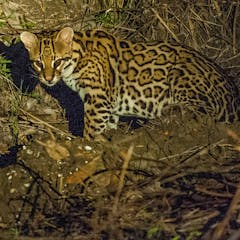
Articles on Wildlife
Displaying 201 - 220 of 654 articles

Birds will shriek and dive at each other over food, territory or mates, but only a small number of species sport actual weapons. The reason: Flying matters more for their survival than fighting.

Data from camera traps around the world provide a strong case to support the designation of protected wilderness areas.

Heavy military vehicles may have kicked up radioactive soil around Chornobyl, and with fighting nearby there’s a danger of harming the concrete shelter containing the radiation of the leaking reactor.

These are poignant cries of a disappearing landscape – the creaking calls of gang-gangs, buzzing bowerbirds and the mournful cry of the far eastern curlew.

Scientists have been testing captive and wild animals for the coronavirus since the pandemic began. Only a few wild species are known to carry the virus, but many more have been shown to be susceptible.

African wild dogs are used to evading hyenas and lions. Genetic research suggests they are using the same strengths to get around human development as well.

A growing body of research shows that COVID-19 protocols should be extended to areas in which there is a human-animal interface such as zoos, wildlife sanctuaries and game farms.

The premise of ‘eco-friendly’ non-fungible tokens is shaky at best.

New research finds the last 250 years has seen more than 100 million hectares of bird habitat destroyed on mainland Australia – that’s 15% of Australia’s landmass.

It may not be extinct, but our research suggests the buff-breasted button-quail may only be hanging on by a thread, at best.

New research finds Queensland’s laws fail to protect private conservation areas from the hidden impacts of mining on groundwater.

Quenda are one of few remaining digging mammals in Australian urban bushlands, and fungi is their favourite food.

Beavers in our landscapes have great potential to provide small-scale adaptations to climate change – if humans can figure out how to live with them.

Forests around the world will need to shift their ranges to adapt to climate change. But many trees and plants rely on animals to spread their seeds widely, and those partners are declining.

Animals are surprisingly good at avoiding fire - but can they survive the unprecedented megafires we now face?

It’s usually good news when a once-scarce species starts to recover – unless it starts getting in humans’ way. An ecologist explains how science can help predict unwelcome encounters.

In China, the wildlife trade is thriving, driven by the increased demands for luxury goods and traditional medicine. But there is real concern about the threat of diseases that can cross over to humans.

This is no simple story, but one of a generational mining community on the brink of social change and an often thankless, hard-won battle for ecological recognition in the heart of coal country.

Northern Australia’s tropical savanna is one of the most fire-prone regions on the planet. We need to change the way we manage fires so we can help native wildlife come back from the brink.

There are so few wild ocelots in the US that the cats are becoming inbred, with a bad prognosis for their ultimate survival. But researchers are perfecting ways to get new genes into the population.
